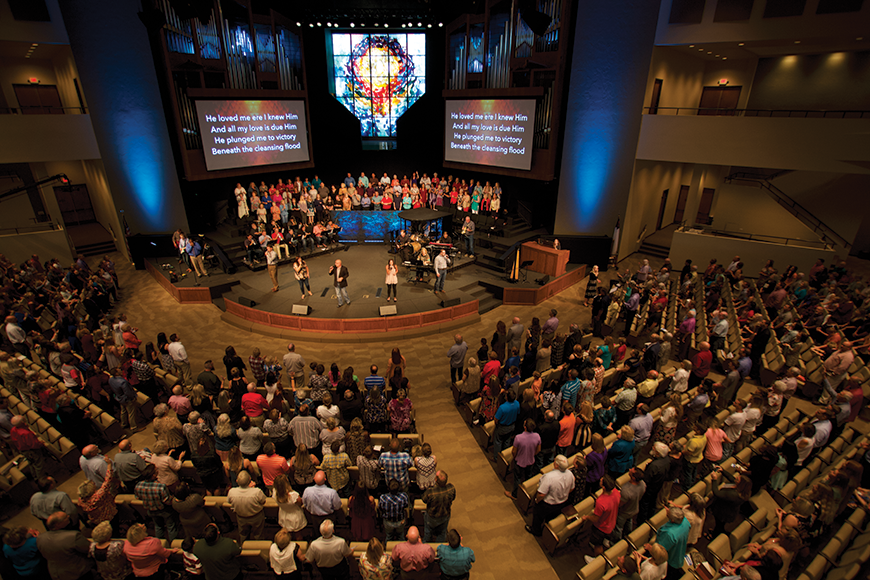Video is central to the ministry of First Baptist Church Texarkana. The Texas-based church has been using local television broadcasts to spread its message of faith for more than five decades, and its emphasis on video has continued to grow under the leadership of Pastor Jeff Schreve, who joined FBC Texarkana in 2003. Under Schreve’s direction, FBC Texarkana has expanded its reach by broadcasting content on national and international cable networks and streaming over the internet.
Schreve also recently spearheaded an ambitious two-year project that saw FBC Texarkana make several upgrades to its sanctuary and production spaces. The project included a dramatic facelift to the sanctuary décor, complete with new theatrical lighting, seating, carpets, paint—the works. But overhauling the physical look of the space wasn’t enough; church leadership also knew it needed to make a heavy investment in video technology to bring the church’s visual presentation to the next level. This investment included an overdue upgrade from standard-definition cameras and production equipment to HD-capable tech. And, to create a more positive in-house experience for the church’s congregation each week, FBC Texarkana also overhauled its audio system, installing new speakers, mixing consoles, acoustic treatment, and more.
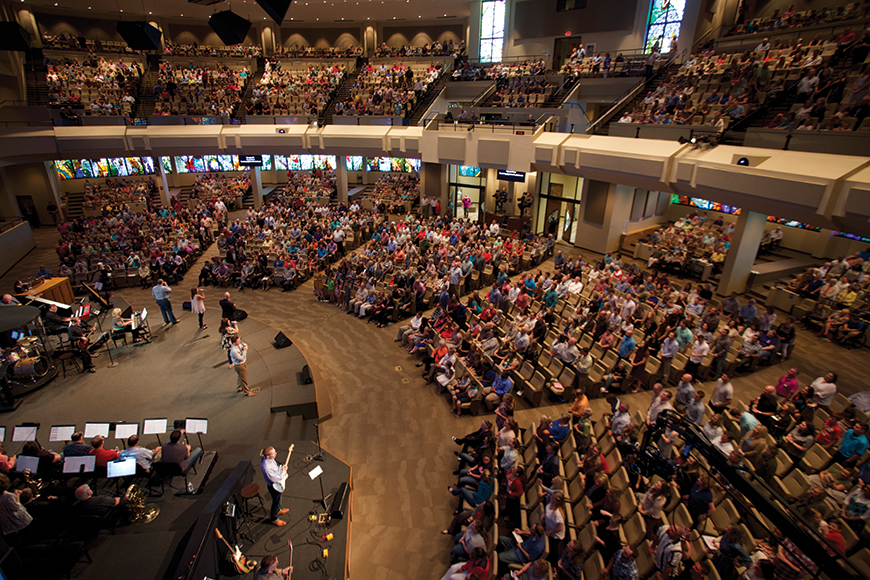
“When you start talking about a project like this, one thing tends to drive another,” FBC Texarkana’s Facility Supervisor Olin Owens explained. “We started talking about the sound. Next thing you know, we can’t do much to the sound system until we do something to the acoustic treatment in the building. And we wanted to upgrade the TV system, so then you look at doing that, and you see the old carpet and pews need to go. So everything ends up driving something else, and we had to pull it all together to make it happen.”
Such a holistic overhaul of the sanctuary involved pulling quite a few threads together, including multiple contractors and trades. And, further adding to the complexity of the project, two separate integration companies were contracted to handle the audio, video and lighting upgrades; Ford AV was tasked with the audio and lighting side of the installation, while The Field Shop handled the video upgrade.
FBC Texarkana’s weekly Sunday services are a blend of traditional and contemporary worship styles. The music leans toward the contemporary side, with drums, bass and electric guitar in play, while still relying on traditional worship music elements like a choir, pipe organ and orchestral instruments. The spoken-word portions of each service are typical of the Southern Baptist milieu, with a 40-45-minute sermon delivered by a single speaker.
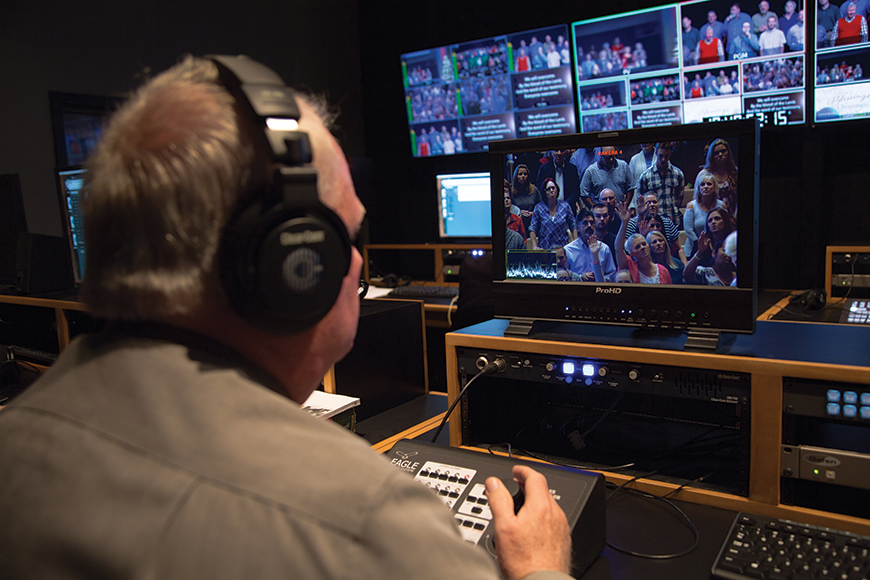
The sanctuary, constructed in 1985, is a fan-shaped auditorium with high ceilings, rounded walls and tiered balcony seating in addition to floor-level seating. “The building is a challenge for a lot of people,” Owens said. “The ceiling height, for one thing, makes it a challenge, and then the circular shape is another thing that’s tough for the sound people. From the floor to the ceiling is an average of 54 to 55 feet, and from the stage to the back wall, it’s about 114 feet.” The sanctuary seats around 2,400, and average attendance at Sunday services is between 1,700 and 1,800. Like many churches, the sanctuary is not an ideal environment for live music thanks to its many reflective surfaces and rounded fan shape. “I don’t think it was built for live-sound purposes. Amplified sound seemed to be an afterthought,” Eric Russell, FBC Texarkana’s Audio Engineer, said.
Before any new audio, video or lighting equipment could be installed, changes had to be made to the building itself to accommodate the new equipment. This included remodeling the venue’s video control room, which is located in a hallway off the balcony. “We had been using SD equipment, so all our screens were SD, and the furniture was made for SD monitors,” Jay Budzilowski, FBC Texarkana’s Director of TV and Media, explained. “We wanted to move to a different setup because, over the years, we’ve added positions, and we started doing IMAG from the control room, and as a result, we were not very streamlined in how we were set up. With the renovations, we were able to set up the positions in a better way—to put the video engineer where he needs to go and put the director where he needs to go.”
To allow for a more streamlined, purposeful workstation setup in the control room, the entire room had to be reoriented. The video control room overhaul was handled by The Field Shop; the team was comprised of President/Systems Engineer Kris Reed, Director of Engineering Pat Reed and Systems Engineer Mike Major. “We spun the room 90 degrees from the way it was before,” Kris Reed described. “The room used to be turned the other way, so it was longer than it was wide. Now it’s wider than it is long, and that allowed us to put more console space in there with two rows of consoles, and to build a larger display monitor wall.” All new control room furniture was custom-built by The Field Shop.’
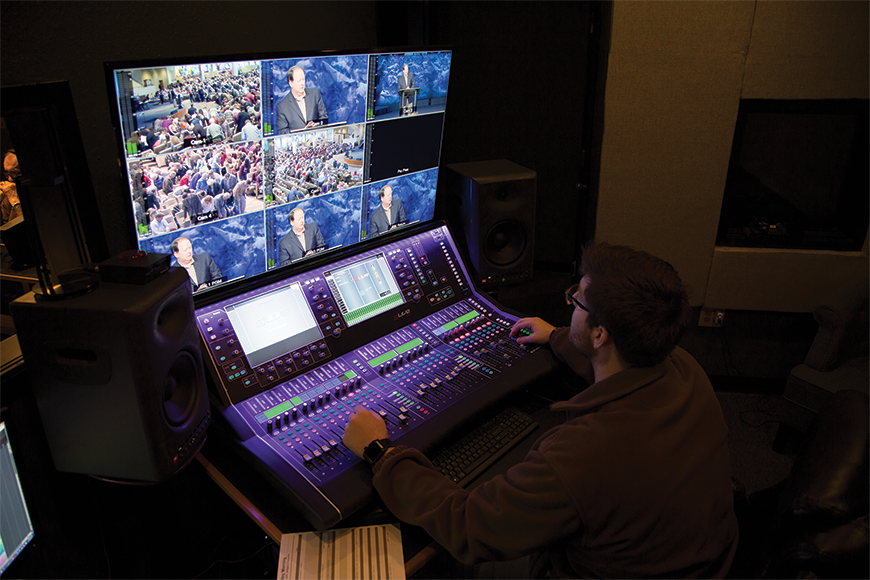
The equipment that was not required for video production was moved from the control room to a newly constructed, dedicated rack room. “In our previous setup, all of the AV equipment was in one room, including everything that made noise,” Budzilowski said. “So we made a separate equipment room for all the rack-mount devices. It cut down on the noise considerably.”
A separate room was also built to house the equipment used to mix audio for the video broadcasts, and it doubles as a recording studio. “The audio-for-video room is attached to the control room,” Budzilowski said. “That’s actually Eric’s office. Previously, he was in a nine-by-six closet. We reoriented the room and made it wider, and constructed a separate recording booth to use for voice overs, music overdubs, etc.”
The video production system is built around a 72×72 Blackmagic Smart VideoHub router. “The Blackmagic router is the heart of the system,” Reed explained. “All sources run into the router, and all destinations are fed out of the router, which allows us to basically route any signal to anywhere, which gives us a high level of flexibility in that system.”
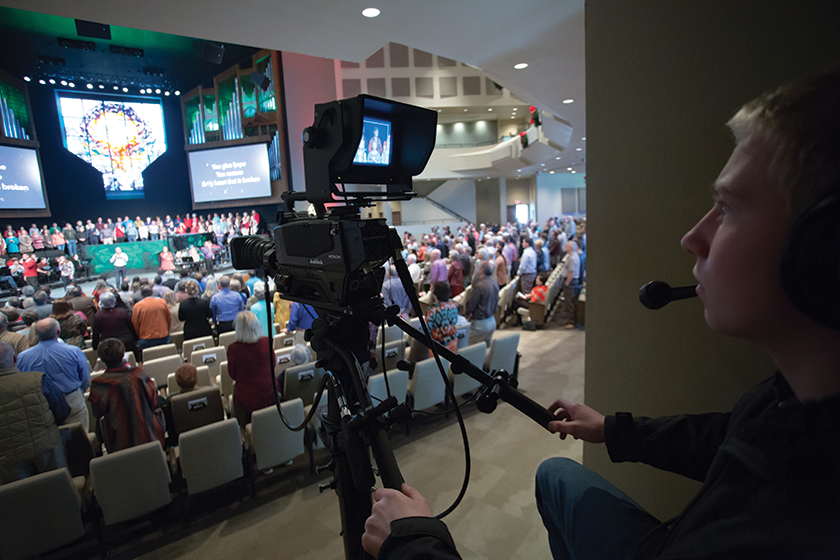
The video control room also contains two Ross Video production switchers: a new Carbonite Black 1, which is used to produce the broadcast TV feed, and a preexisting CrossOver Solo, which is used for the in-house IMAG feed. The feed from the CrossOver Solo is fed to two preexisting (but recently installed) Christie HD projectors, which fire on two motorized screens in the sanctuary. A Blackmagic MultiView 16 and a Blackmagic MultiView 4 round out the video switching system. “Those Blackmagic multiviewers are for monitoring up on the monitor wall,” Reed elaborated. “They allow us to monitor any sources that aren’t readily available within the multiviewers built into the Ross switcher. For example, Ross doesn’t allow you to monitor your aux outputs in their multiviewer, so we have supplementary multiview monitoring systems for things like that, because a lot of times we’ll use the aux output of the switcher to feed the in-house RF system or some other auxiliary feed that needs to be monitored.” The in-house RF system uses a ZeeVee HD modulator to send video signals to lobby displays and overflow areas located within the building.
The display monitor wall is made up of four Samsung 50-inch LED LCD screens. The signals from both Ross Video switchers and both Blackmagic multiviewers are displayed on their own individual screens on the monitor wall.
Three Hitachi Z-HD6000 operator-controlled HD cameras (two on tripods and one on a jib) and two Hitachi DK-H200 cameras mounted on Eagle PT-101 pan/tilt heads are used to capture content for both the broadcast and in-house video feeds. “We have two cameras that are positioned basically rear center,” Reed described. “One camera shoots a tight shot, and then one camera shoots a medium-wide shot. The jib camera is off to stage right. One PTZ is in the rear of the room, stage left, and then the other PTZ is on the stage, also stage left, shooting a reverse angle.” All three Z-HD6000 operators use JVC DT-N17F broadcast studio LCD monitors. The DK-H200s are remotely controlled from the video control room.
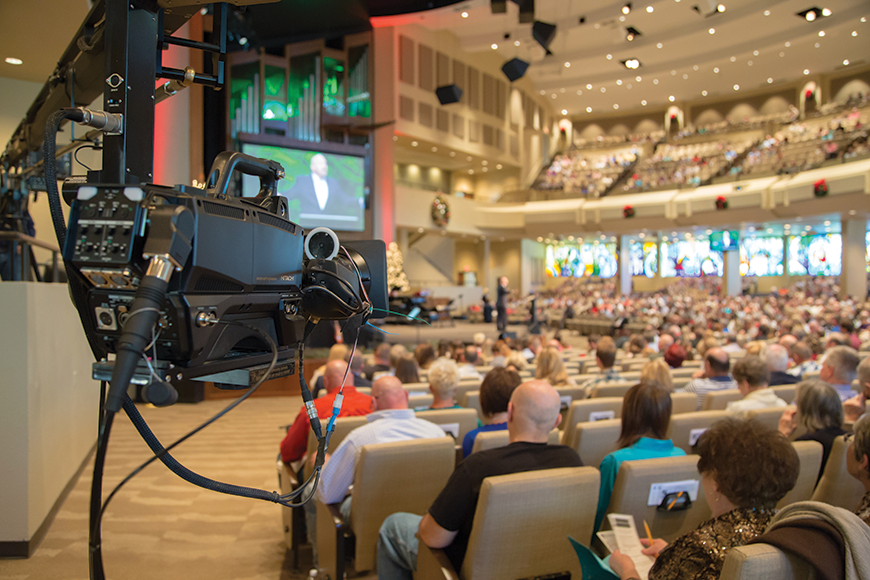 The new HD cameras don’t just boost the resolution of FBC Texarkana’s video content; they also helped solve a problem the video production team was having with low lighting and color quality. “There are some low-light areas in the room, and the new cameras are much better in low-light situations than our old cameras were,” Budzilowski said. “We never need to crank the gain up.”
The new HD cameras don’t just boost the resolution of FBC Texarkana’s video content; they also helped solve a problem the video production team was having with low lighting and color quality. “There are some low-light areas in the room, and the new cameras are much better in low-light situations than our old cameras were,” Budzilowski said. “We never need to crank the gain up.”
An Apple Mac mini running ProPresenter is used by the production team for onscreen graphics and lower thirds. “The Mac mini has one of the Blackmagic UltraStudio 4K devices that connects via Thunderbolt to the Mac,” Reed explained. “That gives us a channel out of the unit so that we can use it in the production switcher to do the lower third keys or any of that other stuff that we want to do, or we can use it in a full-screen graphic mode.”
All of the video content is stored on a makShare media storage server, which is a custom product by The Field Shop. “The makShare media storage server is a shared storage server system that allows the church to have a full seamless end-to-end tapeless workload,” Reed said. “So, they record their media during production directly to the server. As soon as that’s on the server, it’s immediately ready to be edited by any of their five video editors. It gives them a lot of added flexibility to where they don’t have to worry about sneakernetting files or making sure files are on this computer that aren’t on this computer. Everybody is connected to the media server, and they can use files off of that server in real time so they don’t have to copy them.” The makShare media storage server has 60 terabytes of storage. It exists on the venue’s dedicated Wi-Fi network, which also features an Aurora IP control system.
From the server, the broadcast TV feed is distributed to a variety of television stations. “Up until Pastor Jeff came, we were broadcasting regionally out of Shreveport,” Budzilowski said. “He started a separate ministry to fund broadcasting beyond the Texarkana area. Our first station was FamilyNet, and then from there we grew to broadcast on multiple outlets. We’re on TV all over the world now, and we are now on more than 730 radio stations. We produce two versions of our television broadcasts: One is a 60-minute show that airs locally and regionally, and then there’s the ‘From His Heart’ broadcast, which is a 30-minute broadcast that features an edited-down sermon from Pastor Jeff, that airs nationally and internationally.”
Content is also streamed via Facebook Live and hosted on FBC Texarkana’s website. “Online streaming, for me, is a no-brainer,” Budzilowski shared. “If you’ve got a video camera at your church and you have the internet, you’re only a step or two away from streaming online. And we always post all our services online after the fact so people can watch them there, too.”
On the audio side of the installation, the main goals were to update to more modern equipment, address some spotty coverage areas, and expand the input capacity of the system to accommodate the church’s recently adopted, more contemporary music style.
“The old system was one of those deals where you had one microphone at the front, and the worship pastor is going to come up and sing, the preacher is going to get up and talk, and there was a piano and a big pipe organ, which we still use today. At the time, that was all they could foresee happening in that room,” Russell recalled. “And, as worship and music in general changed over the decades, for at least 20 years, we were continuing to do the same thing stylistically. Sometimes we would implement orchestras and things like that back when I was first getting involved here in 2002, but we were very limited in what we could accomplish. We had an analog console that was very limited. We knew there was a need for change.”
Ford AV carried out an extensive modeling process of the sanctuary using EASE. “They were having some issues with coverage along the main floor, as well as some spots up in the balcony,” Ford AV Senior Account Manager Tim Hendrix recalled. “We were able to identify those areas in the assessment that we did and in our analysis of the room.”
The first step was replacing some of the old acoustic paneling with new panels by Perdue Acoustics. “Perdue Acoustics had supplied the acoustical treatment that was in there previously,” Hendrix explained. “Before, they had flat panels on the balcony face but, this time, we went with their Wedge Diffsorber product. In the analysis, there were some areas that were identified where the acoustic treatment could be enhanced, which would help with the sound reproduction in the room itself. I wouldn’t say it was bad, there were just some areas that needed some help. So, through the analysis, we were able to identify that and provide the treatment to work with those areas.”
Once the acoustic treatment was in place, Ford AV specified five JBL PD6322 12-inch three-way loudspeakers to cover the bulk of the sanctuary. Seating on the main floor is divided into five sections, so each of the five speakers is positioned to cover one seating section. Additional speakers include preexisting delayed fills that cover the balcony and under-balcony. The speakers are powered by four Crown DCI amps: specifically, two four-channel amps, and two two-channel amps.
The subwoofers are all preexisting. “Their subs are flown,” Hendrix described. “One of the issues that we were having was that they were getting a lot of low-end on the stage itself, so we put treatment on the ceiling above the stage and adjusted where the subwoofers are located in order to combat that.”
The front-of-house mixing location is located near the front center of the balcony, just a short walk from the video control room, audio-for-video room and rack room. “We went with an Allen & Heath S7000 for their front of house and an S5000 in their production room for their audio-for-video mix,” Hendrix said. These new consoles feature a Dante digital audio interface. “The Dante system just gives them the flexibility that any Dante system gives you as far as routing the signals,” Hendrix elaborated. “They have a full-blown broadcast audio production, and that gives them the flexibility they need to do the switching they need to do.” An Allen & Heath DM64 and DM32 are used for audio inputs, and a BSS Audio Soundweb London BLU-806 handles digital signal processing.
Ford AV was also tasked with upgrading the theatrical lighting in the sanctuary to make it more TV-friendly, particularly with the arrival of the new HD equipment. “They had a lot of dark spots on the stage that were magnified in their television broadcast,” Hendrix said. “We did an analysis of their existing lighting and found that they had quite a few fixtures that were not the right fixture for the location—they didn’t have the right degree of throw on the fixture. There were 10 or 12 fixtures that we ended up replacing the lens tube on to go with a sharper-angled throw, in order to throw the distance that we needed to. Also, they didn’t have any backlighting for the stage, so we added a truss at the upstage back wall and put in some backlighting to give depth to the onstage subjects on camera.” All new lens tubes and backlighting were by ETC. Ford AV also upgraded the lighting control console to an ETC Gio @5.
The AV production staff communicates via a two-channel Clear-Com intercom system, which was installed by The Field Shop. “The 2-channel system allows them to have a production channel and a second channel that can be used for any number of things,” Reed explained. “Having two channels instead of one channel that‘s used by everybody gave them a bit more flexibility. The audio guys don’t really want to be on headset the whole time, so we set up a telephone-style handset with a call-signal flasher, so you can hit the call button and flash those guys when you need them to get on intercom, but they’re not on headset the whole time so they can really focus on doing their audio mix. The video production guys are all on headsets.”
FBC Texarkana was pleased with the work done by both integrators on the project. “The week before we were in the sanctuary the first time, The Field Shop wanted to make sure everything was up and running,” Budzilowski recalled. “We went through every piece of equipment, every signal chain, just to make sure everything was working as it should.” Russell added, “On the audio end, Ford AV was there for us. I would say Ford AV’s Jim Tassey went over and above the call of duty. We had a couple of pieces of equipment that were working fine, and then started failing the day before we were supposed to have our first rehearsal. He called all over the place to find a comparable unit in Dallas and took it upon himself to drive to Dallas that day to pick it up and drive it back, and he had it up and running for us the very next morning when we had our rehearsal.”
For his part, Owens was pleased with how all the various moving parts on the project came together. “To do something like this takes a lot of planning and scheduling,” he said. “It was a scheduling nightmare, quite frankly. But the communication between the contractors and everybody going in and out of the building, including the painters and the carpet people, was really good. They had to work together to get it done. I was really satisfied.”
